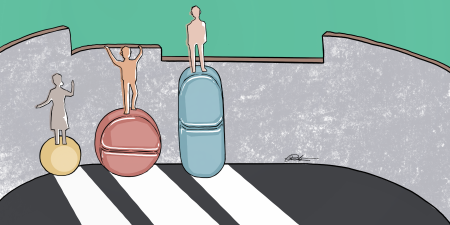Abstract
2020 is not the only time the world has seen opioids ruining the lives of thousands. This article discusses 3 historical episodes in which the need to relieve pain was challenged by the need to prevent and control opioid addiction: the era of iatrogenic addiction in the early 20th century before and after the passage of the Harrison Act of 1914; the shift in attitudes toward and treatment of pain from the 1950s to the 1970s; and the current opioid epidemic, fueled by opioid overprescription and overuse, from the late 1990s to the present. These episodes illustrate the tensions between pain relief and risk reduction and between clinical practice guidelines and modern corporate health care, as well as the stigmatization of chronic illness in American culture and society.
A Catastrophic Toll
The opioid epidemic of the 2000s has destroyed the lives of many Americans and their families. The National Institute on Drug Abuse (NIDA) estimated that 128 overdose deaths occurred each day in 2018.1 The Centers for Disease Control and Prevention (CDC) reported an increase in suspected opioid overdoses in the United States of 30% overall and 70% in the Midwest from July 2016 through September 2017.2 NIDA traces these tragic events to the misleading message spread by manufacturers of opioids in the late 1990s, ie, that patients suffering from severe or chronic pain would not become addicted to prescription opioids.1 This message proved to be false for many; patients became dependent on the prescription drugs and moved on to cheaper and readily available illicit drugs, including heroin and fentanyl.1 A subset of physicians, some motivated by a desire to help chronic pain patients, others by financial gain, exacerbated the problem by overprescribing; many of those who received opioid prescriptions then diverted some or all of their prescribed supply. The results have been catastrophic: in 2018 alone, 47 600 people died from opioid overdoses and an estimated 2 million were regularly abusing opioids3; the problem is still growing.4 Yet a systematic review reports that fewer than 30% of patients for whom opioid analgesics are prescribed misuse them and that only 8% to 12% “develop an opioid use disorder.”1
Despite addiction risks, opioids remain the most inexpensive and available therapy for chronic pain. The CDC estimates that, in 2016, 20% of US adults (50 million) suffered from chronic pain, and 8% of US adults (19.6 million) had high-impact chronic pain, with higher prevalence of both among women, older adults, and adults living in poverty, among other groups.5 Chronic pain is an epidemic that not only destroys lives but also costs the United States “an estimated $560 billion each year in direct medical costs, lost productivity, and disability programs.”5 The suffering caused by chronic pain helps explain why, even as numbers of opioid overdoses and deaths continued to rise, opioid prescriptions per capita increased 7.3% from 2007 to 2012.6
Informal guidelines sought to navigate the clinically and ethically precarious terrain between relief of suffering and avoidance of addiction.
Each one of those prescriptions represented a clinical and ethical choice, perhaps often a difficult one for physicians and patients, who must weigh the risks of drug dependence and its potential effects on health and productivity against the costs of pain in suffering, loss of mobility, functioning, and quality of life. But the dilemma is not a new one. This article considers some historical, cultural, and social factors that have shaped opioid use to treat pain in the United States.
Morphinism and Its Influence on Medicine
The use of morphine for pain became increasingly common in late 19th-century America, where it was readily available without prescription, and often led to morphinism, or addiction, in habitual users. As the 19th-century physician, George Wood, wrote: a general practitioner “[i]n his own therapeutic observation … witnesses frequent disturbances of the functions from its [opium’s] medicinal employment.”7 While physicians valued morphine as an analgesic in their practices, they were often criticized and accused of quackery by colleagues, patients, and observers for encouraging its use and thus fostering addiction.8 Eugene O’Neill vividly dramatized this attitude in Long Day’s Journey Into Night (set in 1912), when the son of a woman addicted to morphine shouts furiously at his father, “If you’d spent money for a decent doctor when she was so sick after I was born, she’d never have known morphine existed! Instead you put her in the hands of a hotel quack who wouldn’t admit his ignorance and took the easiest way out.”9 Medical apprehension over morphinism became more acute after heroin, initially introduced as a safe alternative for pain treatment, quickly became a street drug and was recognized as more highly addictive.10,11 An alarming New York Times report on heroin and morphine addiction in 1913 stated pointedly that “twenty-three percent of the medical profession … were now victims of the morphine habit” and recommended prohibition of the drugs: “The loss to medicine, whatever it might be … would be worthwhile in view of the possible benefits.”12
Legal Roots of Stigma in the Harrison Act
The Harrison Act of 1914 prohibited the sale of opioids without a registered physician’s signed prescription; its passage was not initially opposed by the American Medical Association,13 perhaps in part because physicians hoped it would relieve them from being charged with causing iatrogenic addiction. The act specifically exempted physicians’ use of morphine when “personally attend[ing]” a patient and appeared to leave physicians unfettered to maintain or treat users of opioids.14 However, the Treasury Department charged with the law’s enforcement determined that maintaining chronic opioid use was not legitimate medical practice. In the 1920s, Treasury agents prosecuted physicians and closed city and state clinics that attempted to treat those who were addicted.13 The Supreme Court backed the Treasury Department’s position in a series of decisions, ruling, for example, in Webb et al v United States (1919) that “to call such an order for the use of morphine [for maintenance] a physician’s prescription would be so plain a perversion of meaning that no discussion of the subject is required.”15
Need for Pain Relief: Behavioral or Medical Disorder?
Lawrence Kolb’s studies of the 1920s portrayed most opioid addicts as psychologically and morally deficient,16 which supported the legislative and judicial precedents that users of opioids should not be considered patients with a medical disorder.17 The medical literature of the following half-century suggests that many physicians excluded those who were addicted from their practices and reserved opioid prescriptions for the comfort of patients with terminal illnesses or for the short-term relief of patients experiencing postinjury or postoperative pain. These informal but well-understood guidelines that developed in practice—days of life remaining, dosage amounts, and intervals—sought to navigate the clinically and ethically precarious terrain between the relief of suffering and the avoidance of addiction.18 For example, as surgeon Warren Cole wrote in 1956:
We must appreciate that severe constant pain will destroy the morale of the sturdiest individual. On many occasions the terminal phase progresses so rapidly that there is not enough time, between onset of the severe pain and death, for addiction to become very important…. But since it is … impossible to predict duration of life with cancer, we are often loathe to give liberal amounts of narcotics because the drug addiction itself may become a hideous spectacle.19
Nurse Ada Jacox described, in 1977, how the prescription decisions played out on hospital wards and stigmatized patients asking nurses for pain relief:
They show this concern [about addiction] by withholding medication because it is still ‘one-half to three-fourths of an hour early’ before the four-hour interval between dosages expires…. Instead of evaluating the effectiveness of the current dosage and frequency, the battle goes on repeatedly with the patient complaining of pain two or three hours before the medication is given and the nurse insisting that the patient must wait. The patient becomes more irritable and anxious as his pain increases; meanwhile, the nurse becomes impatient and begins to believe that the patient … is addicted to his medication. The drama is absurd.20
Attitudes toward opioid pain relief underwent a culturally complex change in the late 1960s as a result of increases in drug use and addiction among middle-class users of opioids and Vietnam veterans, coupled with the availability of a new opioid addiction treatment, methadone maintenance. These developments gradually led to the recognition of addiction as a medical disorder, although moral stigma still attached to users with low incomes and to people of color.17
The Pain Field and Advocates of Opioid Therapy
In the 1970s, the formation of the pain management field focused attention on the undertreatment of chronic pain and on respect for a patient’s self-report: “Pain is what the patient says it is.”21 Pain management advocates, such as John Bonica, championed multidisciplinary pain clinics, which offered modalities such as cognitive behavioral therapy and physical therapy. But such programs were expensive, time intensive, often not covered by insurance, and considered by many to place an unfair burden on patients to adjust their lifestyles.22,23 In the 1980s, cancer pain specialists, such as Russell Portenoy and Kathleen Foley, supported long-term opioid therapy—first for cancer pain and then for severe chronic pain patients—coupled with “the intensive involvement” of the physician, as the more ethical choice to enable the patient to regain meaningful quality of life. Portenoy and Foley suggested that opioid use need not lead to addiction and stigma for pain patients;24,25 not all pain management specialists agreed.26
Genesis and Spread of the Epidemic
In the late 1990s, some pharmaceutical manufacturers converted this ethical choice into a marketing strategy. They separated chronic opioid therapy from medical “intensive involvement” and aggressively encouraged opioid prescription for those with moderate pain, as well as for chronic pain patients who overused the drugs and became addicted.17 Although CDC and pain society guidelines attempted to remap the clinically and ethically precarious terrain of opioid prescription, incorporating their recommendations into actual practice often involved time-consuming procedures that were difficult to integrate into corporate health care practices.27 As the epidemic grew, Drug Enforcement Administration regulation and state monitoring of opioid prescriptions burgeoned in response.28 While regulatory sanctioning was enhanced, social stigma was tempered by compassion, as many people struggled to help family members and friends who were overusing and at risk for death by overdose.4 The practice decisions today of physicians treating a patient with pain or a patient at risk for opioid use disorder have been framed by a century of history.
References
-
National Institute on Drug Abuse. Opioid overdose crisis. https://www.drugabuse.gov/drugs-abuse/opioids/opioid-overdose-crisis. Revised April 1, 2020. Accessed April 28, 2020.
- Vivolo-Kantor AM, Seth P, Gladden RM, et al. Vital signs: trends in emergency department visits for suspected opioid overdoses—United States, July 2016-September 2017. MMWR Morb Mortal Wkly Rep. 2018;67(9):279-285.
-
US Department of Health and Human Services. What is the US opioid epidemic? https://www.hhs.gov/opioids/about-the-epidemic/index.html. Accessed April 7, 2020.
-
Quinones S. Dreamland: The True Tale of America’s Opiate Epidemic. New York, NY: Bloomsbury Press; 2015.
- Dahlhamer J, Lucas J, Zelaya C, et al. Prevalence of chronic pain and high-impact chronic pain among adults—United States, 2016. MMWR Morb Mortal Wkly Rep. 2018;67(36):1001-1006.
- Dowell D, Haegerich TM, Chou R. CDC guideline for prescribing opioids for chronic Pain—United States, 2016. MMWR Recomm Rep. 2016;65(1):1-49.
-
Wood G. A Treatise on Pharmacology and Therapeutics or Materia Medica. Philadelphia, PA; 1868. Quoted in: Musto DF, ed. Drugs in America: A Documentary History. New York, NY: New York University Press; 2002:223.
-
Oliver FE. The use and abuse of opium. In: Third Annual Report. Boston, MA: Massachusetts State Board of Health; 1872. Quoted in: Musto DF, ed. Drugs in America: A Documentary History. New York, NY: New York University Press; 2002:216.
-
O’Neill E. Long Day’s Journey Into Night. New Haven, CT: Yale University Press; 1956:142.
-
Manges M. A second report on therapeutics of heroin. New York Med J. 1900;71:51-80.
-
Pettey GE. The heroin habit, another curse. Alabama Med J. 1902-1903;15:174-180.
-
Say drug habit grips the nation. New York Times. December 5, 1913. Quoted in: Belenko SR, ed. Drugs and Drug Policy in America: A Documentary History. Westport, CT: Greenwood Press; 2000:43.
-
Musto DF. The American Disease: Origins of Narcotic Control. Oxford, UK: Oxford University Press; 1999.
-
Harrison Act of 1914, Pub L No. 223, 38 Stat 785.
-
Webb et al v United States, 249 US 46 (1919).
-
Kolb L. Types and characteristics of addicts. Ment Hyg. 1925(9):300-313.
- Acker CJ. Stigma or legitimation? A historical examination of the social potentials of addiction disease models. J Psychoactive Drugs. 1993;25(3):193-205.
-
Meldrum ML. The property of euphoria. In: Meldrum ML. Opioids and Pain Relief in Historical Perspective. Washington, DC: IASP Press; 2003:194-199.
-
Cole W. Foreword. In: Schiffrin MJ, ed. The Management of Pain in Cancer. Chicago, IL: Year Book; 1956:7-8.
-
Jacox A. Pain: A Source Book for Nurses and Other Health Professionals. Boston, MA: Little, Brown; 1977:384.
- Mehta M. The pain relief clinic. Pharmacol Ther. 1981;12(2):373-380.
-
Meldrum ML. Brief history of multidisciplinary pain management of chronic pain. In: Schatman ME, Campbell A, eds. Chronic Pain Management: Guidelines for Multidisciplinary Program Development. New York, NY: Informa Healthcare; 2007:1-14.
-
Baszanger I. Inventing Pain Medicine: From the Laboratory to the Clinic. Rutgers, NJ: Rutgers University Press; 1998.
- Meldrum ML. The ongoing opioid prescription epidemic: historical context. Am J Public Health. 2016;106(8):1365-1366.
- Portenoy RK, Foley KM. Chronic use of opioid analgesics in non-malignant pain: report of 38 cases. Pain. 1986;25(2):171-186.
- Ballantyne JC, LaForge KS. Opioid dependence and addiction during opioid treatment of chronic pain. Pain. 2007;129(3):235-255.
-
Centers for Disease Control and Prevention. Common elements in guidelines for prescribing opioids. https://www.cdc.gov/drugoverdose/pdf/common_elements_in_guidelines_for_prescribing_opioids-a.pdf. Accessed April 7, 2019.
- Joranson DE, Carrow GM, Ryan KM, et al. Pain management and prescription monitoring. J Pain Symptom Manage. 2002;23(3):231-238.



